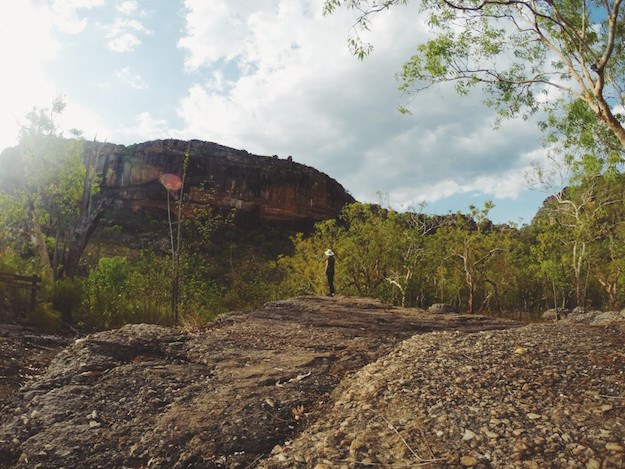Australia's outback is a curious place. Any length of a walk along the fiery red earth will stain your toes a copper orange. People will warn you that beyond your line of sight are fearsome creatures such as spiders, snakes, dingoes, and crocodiles hiding in the bushes in some remote landscape. In my few weeks of exploring, no fearsome creatures were met, unless you count the kangaroos and wallabies with an affinity for darting in front of cars.
 Uluru is also known as Ayers Rock, and is probably Australia’s most recognized landmark. It is 3.6 kilometres long and 1.9 kilometres wide.
Uluru is also known as Ayers Rock, and is probably Australia’s most recognized landmark. It is 3.6 kilometres long and 1.9 kilometres wide.
Most of the ancient land Australia occupies is a dusty plain known as the outback. A sparsely populated arid region, with harsh conditions and out of this world landscapes. That the Aboriginals have managed to survive here for 50,000 years is impressive enough, the fact they thrived for much of that history is beyond comprehension.

Adopting a hunter-gatherer lifestyle, Aboriginal peoples lived mostly nomadically and followed the food sources throughout the seasons. Believing they have come to this earth which was described as once a desolate and featureless place, all Aboriginals share a similar religious sequence of events known as Dreamtime. Despite there being hundreds of dialects and hundreds of separate tribes, creation came from the land and with the land came the language, knowledge, and faith.
 Kakadu National Park is Australia’s largest national park at nearly 20,000 square kilometres, and is co-managed by Parks Australia and Australia’s aboriginal people.
Kakadu National Park is Australia’s largest national park at nearly 20,000 square kilometres, and is co-managed by Parks Australia and Australia’s aboriginal people.
Each area of the outback has its own challenges. In the far north of the Northern Territory, lies one of the outback’s spectacular areas known as Kakadu National Park. Stretching across an enormous escarpment and with stone mountains rising above the plateau, Kakadu has two seasons: dry and wet.
Nearly all year long the temperature is scorching hot, however, in the wet season the humidity peaks and floodwaters rise. During the wet season, huge scores of the park become off limits as the flood waters regularly cut off highways so much that each dip in the road comes with a measuring stick to guage how deep of a puddle it could turn into.

The scarcity of food supplies can be imagined in the blistering heat, but it is due to the wet seasons that the abundance of the land in certain times that have left a lasting mark in this area.
Found etched into a timeless landscape are some of the world’s greatest rock art collections dating up to 20,000 years ago. The red iron oxide stains the rocks with pictures of tools used, animals hunted as well as activities are still done to this day. Within the three major sites of this park, paintings even depict the arrival of the Europeans.
Outdoor galleries such as these are rare in the world, and to have such a vast collection that tells the stories of the Aboriginals culture is a true wonder.
Rock art is also prevalent in Australia’s more famous outback outpost, Uluru National Park, dating back to about 5000 years ago. Rising 348m above the plains, the massive red surface of Uluru is described not as a rock but as a living thing.
Watching the sunset which turns the hues from a dusty orange to deep red and there will be no doubt that there is some magic in this place.
Despite living in conditions that reach 47 degrees Celsius (116 Fahrenheit), the Anangu people have resided in this region of Central Australia for at least 30,000 years surviving off the land. These days, it is a four and a half hour drive from the nearest ‘big city’ Alice Springs.
Between the park and the city, cattle stations nearing the size of Belgium take up space. These days, typical services run by government are supplied by air. The Royal Flying Doctors and the School of Air are just two ways that kids in the outback can be connected to have treatments or an education that would have otherwise been out of reach.
By no means is life in the outback easy. But it is a place that has a simple and harsh beauty that will leave an impression on all those who visit.
 While it is not illegal (currently) to climb Uluru (Ayers Rock) it is strongly discouraged. Visitors are asked not to climb it out of respect for the local culture. For those who do decide to climb it, it can be risky. Uluru is 348 metres high, and it can be steep and slippery, with climbers facing extreme heat and wind. At least 35 people have died climbing this challenging monolith.
While it is not illegal (currently) to climb Uluru (Ayers Rock) it is strongly discouraged. Visitors are asked not to climb it out of respect for the local culture. For those who do decide to climb it, it can be risky. Uluru is 348 metres high, and it can be steep and slippery, with climbers facing extreme heat and wind. At least 35 people have died climbing this challenging monolith.
Photo credits: Rachel Kristensen
These photos were produced after a small group tour to Australia in November 2017. You can check out our other tours of Australia, and if you're already down under, why not consider a trip to New Zealand?